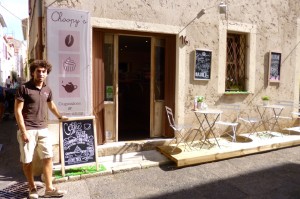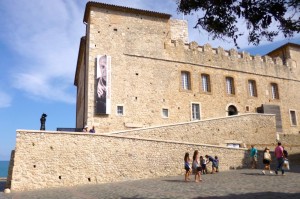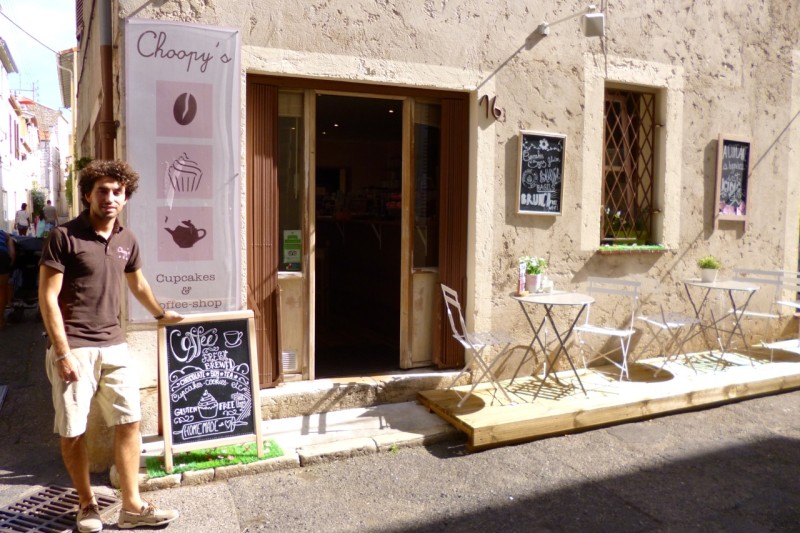French Lessons hands its pen over to its first-ever guest writer today – and who better to fill the role than the witty Philippe! Here’s his keen-eyed view of the world, focusing – as friends would expect him to do – on the more curious and jaw-dropping ills of France’s imploding economy.
“C’EST LA CATASTROPHE!” Angela, our real estate guru, declares with great animation over a lunch of pave de saumon and ratatouille provençale. It’s hardly the food that has her down. The world around her is a complete catastrophe because of declining visitor numbers.
Since our family’s arrival in Antibes in mid-June, there have been visibly fewer people at the beaches, golf courses and markets than last year. Fairly incredibly, you can even spot free parking spaces in town.
Du jamais vue! Never seen anything like it! Angela says. This season, the summer of 2014, is the fifth year in a row that tourism numbers have fallen – not only in Antibes but on the whole of the Côte d’Azur. “All the main street merchants are clamouring for the City to do something,” she says.
Of course they are. In France, the State is the answer to everything. During the good times from 2002 to 2008, prices in Antibes went up well past what was reasonable. Now everyone suffers the consequences. A cup of coffee in the old town sets you back $5, and a beer at Le Crystal, a well-established bar in Juan-Les-Pins, will drain you of $14. Tourism in Spain, meanwhile, is up 42% this summer. Guess where everyone has gone?
Or take ice cream. Even Marc, the friendly owner of Pinocchio’s, the best ice cream shop in Juan-les-Pins, tells me his numbers are down 20% from last year. “We are the last thing anyone cuts,” he says, “because for a few euros you can always please yourself with an ice cream cone.”

This summer Jemma and I discovered Choopy’s, a coffee shop in the heart of old Antibes that has the best cappuccinos in town. Each mug is finished off with a touch of latte art by Victor, third-place winner of the 2013 France Latte Art Competition. Choopy’s also has WiFi, which came in handy as ours at Bellevue was out for no less than three weeks. (Nothing gets done fast around here.)
It so happens that one of my New Year’s resolutions was to learn how to create latte art, the milk-foam-and-coffee designs that top off cups in the fancier cafés. Having made lattes at home for over 25 years, I figured it was time to learn something new. One evening I meet Victor near closing time, around 6pm, and for the next two hours he gives me a tutorial on latte art and restaurant ownership in France.
Victor graduated with a master’s degree in international business five years ago. While at university he worked as a bagagiste, a bellboy, in a local hotel where he met Julie, who was finishing her four-year culinary degree and working in the kitchen. Between them, they managed to save $14,000 and upon graduation left to travel in Australia for a year. When they returned to France in 2010, their job prospects were dismal. Today it’s only worse; unemployment for the under-30s now runs over 25% in France. (Among minorities, it’s even over 50%.) So Victor and Julie created their own jobs by borrowing on their Aussie experiences and opening a coffee shop selling cupcakes and art-adorned espresso drinks.
As new entrepreneurs, they soon discovered the full weight of the State. You want a sign on your building with the name of your business? You have to pay a tax to the municipality. You want a few chairs and tables outside? That’s another tax. You want to pipe in music over the internet from the US? There’s a music tax, of course, just like there’d be a TV tax if you cared to offer that feature. These taxes come on top of the more typical real estate, business and value-added taxes. The list goes on and on.
Then you need to hire people. But watch out – the State makes it impossible to fire anyone, and the social charges are infernal, typically adding 75% to an annual wage packet. If, for example, Victor pays an employee EUR 2,000 ($2,700) pre-tax each month, the true cost is more like EUR 3,500 ($4,700) per month. If the employee is single, s/he will net, after-tax, EUR 1,674 ($2,250), making – all-in – an effective 53% tax take by the Government!
France – if we may say so – can hardly call itself competitive. The folks most affected by the country’s unruly tax levels are its small entrepreneurs – those people who are working on thin margins in the first place. But spot the disconnect. Entrepreneurs are the very people creating jobs – in a country with five million unemployed or under-employed citizens! The newspapers don’t report percentages anymore so as not to scare people, but considering that the country’s population is 66 million (including kids and the elderly and those who don’t even care to work), you get the picture. Unemployment is around 10% – surely higher.

So back to Victor and the cupcakes. He and Julie and their two employees sell hundreds of cappuccinos a day, alongside a daily 50-200 cupcakes, and salads and gluten-free bagels to boot – all made fresh by Julie. It’s a punishing existence, Victor says. The couple starts work by 7am, baking and purchasing food fresh from the market in time to open by 9am, 6 days a week, 50 weeks of the year.
Creating wealth under these conditions is next to impossible. Choopy’s managed to eek out a small profit in its first year of business – only to see it evaporate last year.
Since François Hollande’s election as French Président in 2012, more and more taxes have been announced, chasing capital right out of the country. Then in January came the latest twist. Hollande drew the scorn of his fellow countrymen when he was caught by paparazzi visiting his mistress at midnight on a scooter. The French were hardly shocked by the mistress. They were stunned by the fact that, as Président, he lacked total decorum!
Since a string of scandals a few years back – these being of the financial variety – all French ministers are required to declare their net worth. So we decided to take a look. Manuel Valls, the new Prime Minister, is the economically-savvy one. In his 52 years of life, he has managed to garner two apartments of less than 1,000 square-feet each, valued at $770,000 minus loans of $270,000, for a net value of $500,000. Oh, and he has $7,000 in his bank account.
Valls is one of the better-off members of the French Government. Harlem Désir, the 55-year-old State Secretary to European Affairs, has $59,000 in six bank accounts and a 12-year-old minivan that he thinks might be worth $2,000. None of the 32 ministers in the present Government owns a single stock or bond!
Is this Government up to the task of rectifying France’s innumerable ills? Like its gaping budget deficit?
Here’s a real my-my. The last time France had a balanced budget was in 1974! Yep, 40 years ago. Think about it. France hasn’t balanced its books for 40 years – and now that it’s in the middle of a crisis, you think this left-leaning government will be able to do so? Not a chance, I say.
Just to give the reader some perspective, less than four years ago the State of California was the poster child of mismanagement with its record budget deficits and a badly broken political system. The good citizens of that state finally woke up, smelled their gorgeous cappuccinos, and elected to take action. The turnaround has been dramatic. The state’s 2014 budget of $106 billion is not only balanced but it has a tidy surplus of $6 billion.
California has 38 million people, and its GDP is close to $2 trillion. By comparison, the whole country of France counts a much greater population – 66 million – and together all these people produce a national GDP that’s quite similar to that of California at $2.2 trillion. Lots more people for about the same output.
Then we compare the governments’ ledgers. Whereas the revamped California has more than balanced its books, producing an actual surplus on its $106 billion in revenues, France has a budget deficit of $110 billion – more than the whole of California’s entire kitty. And how much did France have in its annual purse to create such an overwhelming gap? A whopping $2.4 trillion!
But, oh, there are such needs for all that money! Who else is going to pay the salaries of the country’s 5.5 million public-sector employees? California only has to worry about paying 410,000 governmental workers. (Okay, maybe this comparison isn’t completely fair as the French State controls some 1,200 companies employing a further 800,000 people, but you get the flavor.)
So, you may ask, how’s the party going to end?
Since Roman times, Governments faced with this situation have made one of two choices: They’ve either embraced austerity by cutting services and raising taxes – as California did; or they’ve defaulted – like Argentina has done many times in the last 20 years – and then these countries have devalued their currencies, imposing a tax on the entire population in order to restore national competitiveness.
In the 20th century, that’s to say from 1905 to 1986, France has devalued its currency no less than 17 times. Devaluation is the easy way out for politicians who don’t want to take hard decisions that they’d have to defend to a population who, at the least sign of change, takes to the streets and throws bricks at its leaders. General de Gaulle himself put the situation into words in the 1960s when as Président he famously said, “How can you govern a country which has 246 varieties of cheese?”
But now France is part of the Euro. The Germans, who had a bad taste of inflation back in the 1930s, will have nothing to do with inflating the single currency. So what’s going to give? My prediction: The French, along with the Italians, Spaniards, Portuguese and Greeks, will end up with a Southern Euro while the Germans, Dutch and Nordic communities will have their Northern Euro.
Two hours and ten cappuccinos later, Victor’s two most precious bits of advice to this keen student were these: First, produce a great espresso with rich dark foam. Then, second, froth whole milk to the consistency of paint. Once you attain this gloriously state of creaminess, you should be able to hold the stainless steel frothing pitcher with your bare fingers for three seconds without burning them. Any hotter and les micro-bulles, the tiny bubbles in the milk, get too big and you lose the consistency required to make beautiful latte art.

Then, and only then, you’re ready to create. If you can make a white circle in the center of your cappuccino, Victor says, you’re on your way to designing anything.
Yeah, sure, and 1,000 cappuccinos later I’ll be perfect! I’m already dreaming of the day I can make a beautiful heart for Jemma on her breakfast cappuccino. It may look like a circle, but I’m sure she’ll take it as a heart!
The day after my session with Victor, I lunch with the Director of the Picasso Museum here in Antibes. Jean-Louis looks like an artist with his disheveled hair, five-day beard, jeans, t-shirt and a well-worn corduroy jacket. His budget at the museum was cut 40% two years ago by the town’s mayor, he tells me, but he was admonished not to lay off any employees. Now he has employees who can’t do anything because he has no money to produce new exhibitions.

Jean-Louis is fortunate, though. People keep coming to the Picasso Museum because most visitors are tourists, and they’ll come simply because Picasso is Picasso. For most museums, though, such a budgetary slash would spell death. Is the Picasso Museum’s head bitter?
Not a chance, he says. Look around. Where else in the world would you rather live?
He’s got a point. So I ask him, Do you think the French will change and finally elect politicians who can take the hard decisions?
Jean-Louis shakes his head. France, he says, is old. Have you ever tried to change the mind of old people?


So sad! We’ll send our President to you………. he’ll straiten out your country in no time!!!!!!
It seems to me that beautiful , economically challenged France will have sister-like relationships with the US, California, Illinois, New York, etc. Who elects these people??????
Le Crystal is undoubtedly a posh place, and the $14 beer was probably something other than Miller Lite—-but $14 for a beer————REALLY!!!!!!!!!!!!!!!
The next time you visit your mother-in-law, the Stitchers would like to have you demonstrate your latte art.
Pat Vandiver
THIS IS A PREVIEW OF ONTARIO IN 10 YEARS. ITS AMAZING IN AN AGE OF COMPLETE INFORMATION AVAILABILITY THAT GOVTS. CAN BE SO STUPID. WHEN A COUNTRY EATS ITS YOUNG AND PANDERS TO
MOSLEM EXTREMISTS ITS GOING TO BE A SORRY PLACE TO LIVE. SEYMOUR
The article should be published in The Economist! It was such an easy read and I learned so much about France’s economy! – Erin
This was so very informative and I enjoyed the witty writing. The “guest” author is deserving of a bottle of good wine (no mere beer will do-even at that price). I look forward to hearing from him again!
A colorful but dramatically realistic essay! Unfortunately, the leftist mentality seems to exist in France ever since Marie-Antoinette was beheaded. This magnificent country is a total and unsolvable economic disaster: a real ”catastrophe, mon cher”. Enjoy…even if it’s not really funny!
Bravo, Italy is even worse and it should be the richest country in the world.